Table of contents
- Always make sure you are running the latest version
- Menu is not showing
- Reset all the settings
- Disable ReShade
- Missing Visual C++ system component
- Start in Safe mode
- Disable other OpenXR API layers
- Inspect the log file
- Missing DirectX legacy runtime
- Disabling the OpenXR Toolkit with incompatible applications
- Checking if you are CPU or GPU limited
Always make sure you are running the latest version
Before starting troubleshooting, always make sure you are running the latest version of the following:
Latest version of your OpenXR runtime. This is typically updated or installed via the Windows store (for Windows Mixed Reality) or the vendor’s software (for Oculus, Varjo). Sometimes, you will need to manually check the vendor’s website (for Pimax unofficial runtime for example).
Latest version of OpenXR Toolkit, downloadable from the front page of this website.
Latest version of your graphics drivers.
Half of the “something does not work for me” issues are resolved by updating to the latest software.
Menu is not showing
There are a few common situations leading to this issue.
Make sure your application uses OpenXR
OpenXR Toolkit only works with OpenXR applications. Not all applications are built for OpenXR. See the index#supported-applications for a list of applications known to work.
After running your application for the first time, open the OpenXR Toolkit Companion app, and inspect the list of applications:
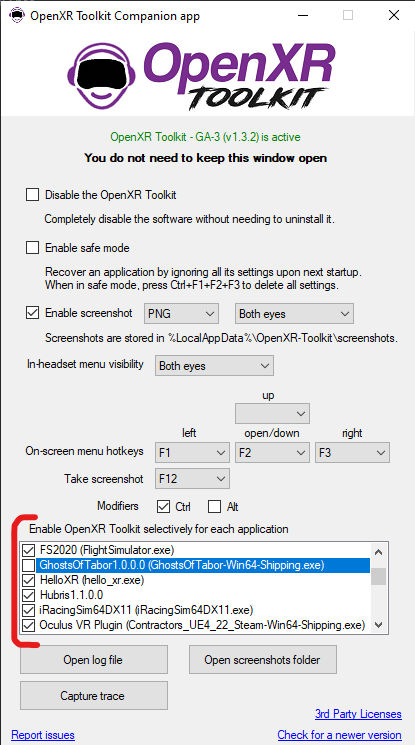
The list of recognized applications
If your application does not show up here: your application is not built using OpenXR. The OpenXR Toolkit will not work.
Try the legacy menu mode
Certain versions of the OpenXR runtime have issues with 2D overlays like the OpenXR Toolkit menu. Try switching to “legacy mode”. Enable Safe mode before starting the application:
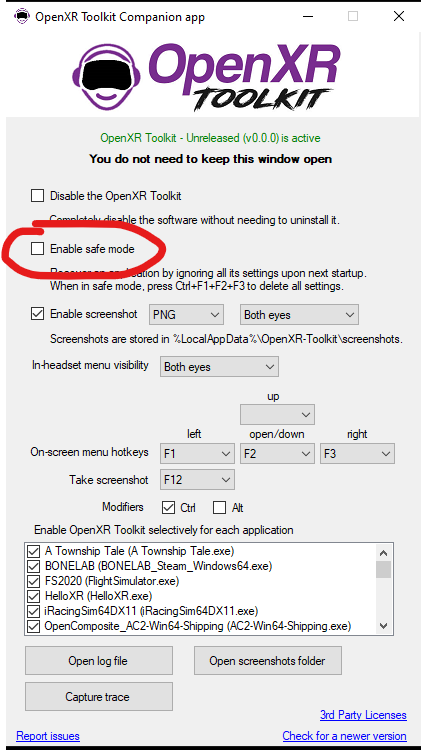
Enabling safe mode
Hopefully, the menu will now be displayed. Navigate to the Menu tab, then toggle Use legacy mode to On:
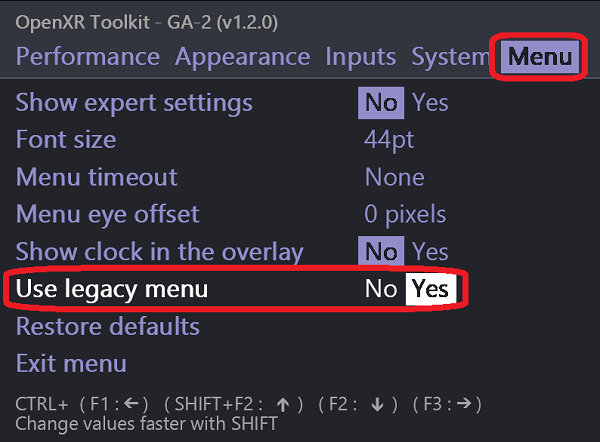
Enabling legacy menu
You can now disable Safe mode and start your application normally.
Make sure your keyboard works correctly
This has been reported due to certain keyboards requiring special key presses to use the Function keys (such as Fn+F1 for example). This can also be due to 3rd party software intercepting the Function keys.
Use the Keyboard tester to check if your key combinations work.
Please use the OpenXR Toolkit Companion app to try different hotkeys, selecting keys other than the Function keys.
Reset all the settings
While an application is running, you may at any point reset all the settings to their default values by pressing simultaneously the keys bound to all 3 of the menu actions. If no custom key combinations have been set in the OpenXR Toolkit Companion app, this combination is Ctrl+F1+F2+F3. Spam all 4 keys until you see the Welcome prompt display.
You can also navigate to the Menu tab and choose Restore defaults:
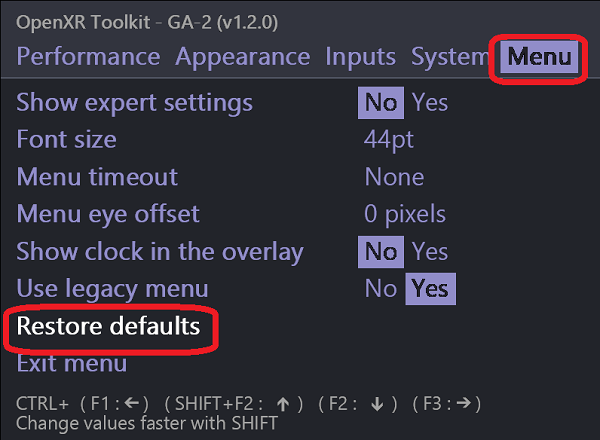
Restoring default settings
Disable ReShade
If you had previously installed ReShade or any similar mod for your application, please disable or delete it in order to use the OpenXR Toolkit.
Missing Visual C++ system component
If the OpenXR Toolkit makes your application refuse to start, try installing the Visual C++ Redistributables.
This issue will manifest itself with the XR_ERROR_FILE_ACCESS_ERROR when using Windows Mixed Reality or inspecting log files.
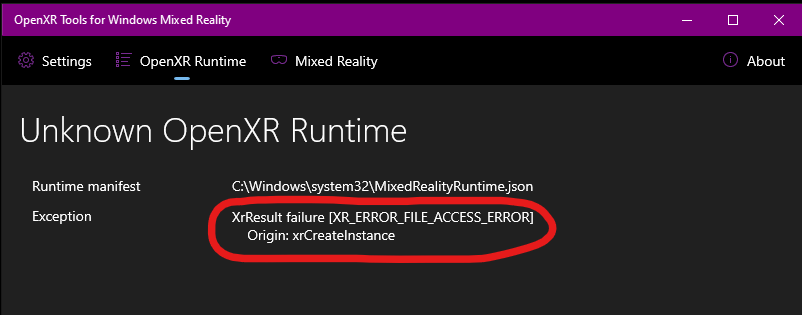
Errors you will see when missing Visual C++ Redistributables
Start in Safe mode
If an application fails to start due to some settings changes, you may use the OpenXR Toolkit Companion app (found on the desktop or Start menu) to Enable safe mode. In this mode, the settings for this application will not be loaded.

Enabling safe mode
You may then either:
Change your settings to avoid the problem. Note that in safe mode, settings are not loaded, but the modified settings are still stored. You may need to toggle a setting on/off a few times to make sure the new value is saved before exiting Safe mode.
Disable other OpenXR API layers
Hover on top of the “OpenXR Toolkit is active” label in the OpenXR Toolkit Companion app to see a list of other OpenXR API layers.

The list of other OpenXR API layers in use on your system
Try disabling or uninstalling them and see if the problem is resolved.
Inspect the log file
In order to inspect the log file to try to understand issues with the toolkit, you may open the OpenXR Toolkit Companion app (found on the desktop or Start menu) and click the Open log file button. This will open the file located at %LocalAppData%\OpenXR-Toolkit\logs.

Accessing the log file
Please note that certain applications may run in a security-sandbox environment. In this case, the log file may be located under the corresponding application subfolder in %LocalAppData%\Packages. You may search for a file named XR_APILAYER_MBUCCHIA_toolkit.log if unsure of the exact location.

An example log file
Missing DirectX legacy runtime
Check for the following error in the log file:
[OXRTK] 2022-02-28 20:41:32 -0600: HRESULT failure [80004005]
Origin: m_fontWrapperFactory->CreateFontWrapper(get(m_device), m_fontFamily.c_str(), set(m_fontNormal))
To solve this problem, please install the DirectX legacy runtime package.
Disabling the OpenXR Toolkit with incompatible applications
You might reach a point where you determine that an application is not compatible with the OpenXR Toolkit. You may use the OpenXR Toolkit Companion app (found on the desktop or Start menu) to disable the OpenXR Toolkit just for that application.

Per-application control
Checking if you are CPU or GPU limited
Perform the test below with any form of motion reprojection or asynchronous space warp (ASW) disabled and any frame limiting/throttling feature disabled (eg: in your driver or NVIDIA control panel).
Use the Detailed overlay (see Overlay) to inspect your application CPU and GPU times (respectively app CPU and app GPU).
When the value of app GPU is greater than the value of app CPU, you are limited by your GPU, and you may use features such as Upscaling or Foveated Rendering to relieve your GPU. If you are not GPU limited, then these features will not help to gain performnce. Instead, you may alter other settings of your application, such as details settings, and increase them until you become GPU limited, and can enable the performance-enhancing features previously mentioned.